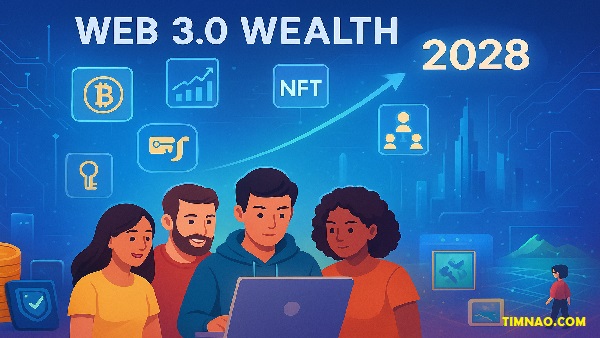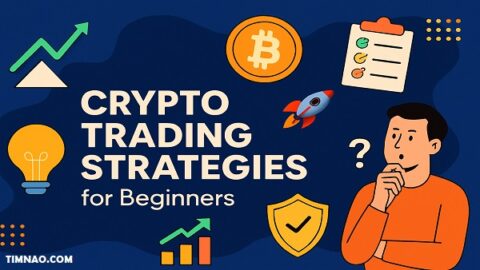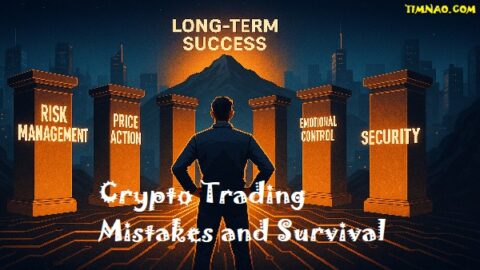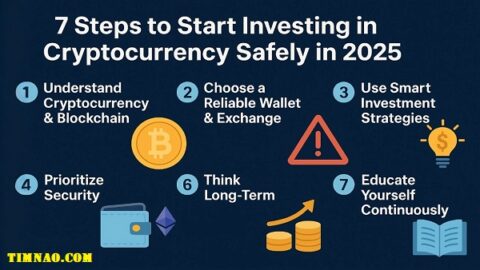💡 The Shocking Truth About Web 3.0 Wealth — How Beginners Can Unlock Life-Changing Opportunities
Web 3.0 Wealth is quickly becoming one of the most exciting opportunities of our time. Unlike the old internet, where giant corporations controlled platforms and profits, Web 3.0 gives ordinary people a chance to own, earn, and participate directly in the new digital economy. From decentralized finance (DeFi) and NFTs to metaverse worlds and community-driven projects, this shift isn’t just for tech experts — it’s for anyone willing to learn and take small, smart steps.
But where should beginners start? With so much information (and misinformation) out there, it’s easy to feel overwhelmed. That’s why this guide breaks everything down into clear, practical strategies you can follow today. You’ll learn how the internet evolved into Web 3.0, why it matters for everyday people, and most importantly, how you can safely begin building your own share of this new wealth system.
Let’s explore step by step — starting with the history of the internet and moving all the way to the opportunities that lie ahead.
📑 Table of Contents
- 🌍 From Web 1.0 to Web 3.0 — How We Got Here
- 🔑 Why Web 3.0 Wealth Matters for Everyday People
- 🏦 Blockchain & DeFi Explained Simply
- 💼 7 Beginner-Friendly Strategies to Start Building Web 3.0 Wealth
-
- Using Crypto Wallets the Right Way
- Exploring Decentralized Exchanges (DEXs)
- Earning with Staking & Yield Farming
- Learning from Airdrops & Early Tokens
- Joining Decentralized Communities & DAOs
- Investing in NFTs Beyond Just Art
- Exploring Metaverse & Play-to-Earn Opportunities
-
- 🔐 Staying Safe: Avoiding Scams & Protecting Your Assets
- ⚖️ The Regulation Wave: What Beginners Should Know
- 🚀 The Path to 2028 — Why Acting Now Matters
🌍 From Web 1.0 to Web 3.0 — How We Got Here
If you’re new to the world of Web 3.0, it might feel like a complicated concept reserved for tech insiders or crypto fanatics. But the truth is, the story of Web 3.0 is simply the next chapter in the internet’s evolution. To understand where we’re going, it helps to look back at how we got here.
The internet we use today didn’t arrive overnight. It has passed through clear stages — Web 1.0, Web 2.0, and now Web 3.0 — each stage shaping how we connect, share, and build wealth online.
Web 1.0: The Read-Only Era
Back in the 1990s, the internet was like a massive digital library. People could browse static pages filled with text and images, but there wasn’t much interaction. Websites such as Yahoo! Directory or AOL Pages were gateways to information, but you were just a reader, not a participant.
Imagine walking into a library where every book is behind glass. You can look, but you can’t write notes or leave comments. That was Web 1.0. It was exciting at the time — email felt revolutionary, and having a personal website on GeoCities was a badge of honor — but it was a one-way street.
This phase laid the groundwork. It created the protocols and basic structure of the internet. But it wasn’t built for conversation, creativity, or commerce.
Web 2.0: The Social Internet
By the mid-2000s, everything changed. Platforms like Facebook, YouTube, and Twitter made the internet interactive. You no longer needed technical skills to publish online. You could upload photos, post updates, or start a blog in minutes. Suddenly, everyone had a voice.
Web 2.0 is the reason we have influencers, viral videos, and global communities that form overnight. It also gave rise to powerful businesses like Amazon and Google, which built platforms billions of people rely on daily.
But there’s a catch. In Web 2.0, the platforms that made sharing easy also became gatekeepers. They provided the space, but in exchange, they harvested your data. The saying “if you’re not paying for the product, you are the product” became a reality. Our clicks, likes, and personal information turned into valuable assets — for them, not for us.
Think about it: Facebook doesn’t charge you to join, but it makes billions from advertisers who pay to target your attention. Google Maps helps you navigate, but your location data is sold to marketers. The wealth of Web 2.0 has been concentrated in the hands of a few tech giants while the majority of users generate content without sharing in the profits.
Web 3.0: The Decentralized Revolution
Now comes Web 3.0, and this is where things get exciting. Unlike Web 2.0, which is dominated by centralized corporations, Web 3.0 aims to hand control back to individuals. It’s built on blockchain technology, which ensures transparency, security, and ownership.
In Web 3.0, you don’t just upload content to someone else’s platform — you can own it. You don’t just use an app — you can hold a stake in the network itself. Your data, identity, and assets are stored in digital wallets only you control, not on corporate servers.
Here’s the simplest way to think about it:
- Web 1.0 = Read
- Web 2.0 = Read + Write
- Web 3.0 = Read + Write + Own
This shift isn’t just technical — it’s philosophical. Web 3.0 changes the question from “How do I use the internet?” to “How do I participate and benefit from it?”
🔑 Why Web 3.0 Wealth Matters for Everyday People
Now, you might be wondering: why does any of this matter to you? After all, most of us are not developers or crypto traders. The reason is simple: Web 3.0 is democratizing wealth in ways the old internet never did.
Lessons from the Past
History shows that in every digital revolution, those who understand and adopt early reap the greatest rewards.
Take the California Gold Rush of 1849. Thousands searched for gold, but the biggest fortunes went to people who sold shovels, jeans, and tools. Levi Strauss, for example, built a clothing empire that still exists today.
Fast forward to the dot-com boom of the late 1990s. Most websites disappeared, but companies that built the infrastructure — Amazon with e-commerce, Google with search, PayPal with payments — became trillion-dollar giants.
The same pattern is repeating with Web 3.0. While millions chase the latest meme coin or flashy NFT, the lasting wealth is being created in the protocols, decentralized apps, and networks that form the backbone of this new internet.
Breaking Free from the Old Model
In Web 2.0, creators often found themselves stuck in a frustrating cycle. They spent countless hours producing videos, blogs, or music, only for platforms to take a massive cut. YouTube keeps about 45% of ad revenue. Apple and Google charge up to 30% for app sales. And most social media creators earn pennies unless they become megastars.
A 2023 report found that nearly 70% of part-time content creators earned under $1,000 per year. That’s hardly a path to financial freedom.
In Web 3.0, this changes dramatically. Imagine posting your content and getting paid directly through crypto micropayments. Imagine owning shares of the platform you help grow. Instead of working for the system, you become a part of it.
Everyday Examples of Web 3.0 Wealth
Here are a few real-world ways everyday people are already benefiting:
- Staking crypto: Instead of letting money sit in a savings account earning less than 1%, people stake Ethereum or Solana and earn higher rewards while helping secure the network.
- Play-to-earn games: Gamers can play titles like Axie Infinity or The Sandbox and earn real tokens that can be traded or sold.
- Selling NFTs: Artists who once struggled to sell their work now mint NFTs and sell them directly to fans without galleries or agents.
- Decentralized lending: Anyone can lend or borrow crypto on platforms like Aave, bypassing banks entirely.
The important thing here is accessibility. You don’t need to be a Wall Street investor to join. With just a phone and a wallet app, you can participate.
The Big Picture: A Fairer Digital Economy
The wealth gap in Web 2.0 was massive — a few companies became trillion-dollar giants while billions of users remained unpaid contributors. Web 3.0 promises a reset. By distributing ownership and rewards more fairly, it gives everyday people a chance to participate in wealth creation.
That doesn’t mean everyone will get rich overnight. It means the tools of financial empowerment are no longer locked away behind banks, governments, or big corporations. Anyone willing to learn and take small steps can carve out their share of this new digital economy.
Web 1.0 let us read. Web 2.0 let us write and connect. Web 3.0 lets us own and benefit.
This shift matters because, for the first time in internet history, ordinary users can participate directly in wealth creation instead of just feeding the platforms that profit from them.
For beginners, the key is to start learning now. The earlier you understand wallets, decentralized apps, and digital ownership, the better positioned you’ll be when Web 3.0 hits mainstream adoption.
And remember: you don’t need to chase the hype. Just as the gold rush rewarded those who sold shovels, Web 3.0 will reward those who understand and adopt the foundational tools.
The internet is entering a new era. The question is, will you just be a user — or will you be an owner?
🏦 Blockchain & DeFi Explained Simply
For many beginners, the terms “blockchain” and “DeFi” sound like something out of a tech textbook. But here’s the truth: both ideas are easier to understand than they appear. Think of blockchain as the foundation — the technology that makes Web 3.0 possible. Then picture DeFi, or decentralized finance, as one of the most powerful applications built on top of that foundation.
When you break them down with everyday examples, they stop feeling intimidating and start making sense. Let’s walk through both concepts in a way that even someone new to crypto can follow.
What Exactly Is Blockchain?
At its core, blockchain is like a digital notebook that everyone can see, but nobody can secretly edit. Every time someone makes a transaction, that action is written in this notebook as a permanent entry. Once it’s recorded, it can’t be erased or changed.
In the old world, banks and companies acted as the trusted record keepers. If you sent money to a friend, your bank would update the ledger on your behalf. In blockchain, the community does the work. Thousands of computers around the world (called nodes) verify the transaction, ensuring it’s valid and secure.
Here’s a simple comparison:
- Traditional system → A single librarian keeps the only copy of the book.
- Blockchain system → Thousands of librarians keep identical copies. Even if one tries to cheat, the others reject it.
This makes blockchain highly secure, transparent, and resistant to fraud. It’s the reason people trust it even without a central authority.
Why Blockchain Matters for Beginners
You might be thinking: “Okay, but how does this help me?” The biggest benefit is ownership and transparency. On blockchain, you control your assets through a digital wallet. No bank can freeze your funds. No company can sell your data without permission.
It also opens doors globally. Imagine sending money to family in another country. A bank wire might take three days and cost $30 in fees. With blockchain, you can send stablecoins like USDC or USDT in minutes for pennies. That’s the power of decentralized transactions.
For beginners, this means blockchain isn’t just about trading Bitcoin. It’s a system that makes everyday money movement faster, cheaper, and more open.
From Blockchain to DeFi
Once you understand blockchain as a secure, shared ledger, DeFi becomes easier to grasp. DeFi — short for decentralized finance — is basically “finance without middlemen.”
In the traditional system, banks and brokers control everything. Want a loan? You need approval. Want to earn interest? You accept whatever low rate the bank offers. Want to trade stocks? You pay fees.
In DeFi, smart contracts (self-executing code stored on blockchain) replace middlemen. These contracts can lend, borrow, trade, or pay interest automatically — without needing a bank employee or broker in the middle.
Think of DeFi as a giant financial toolkit where anyone can access services with just a smartphone and a wallet.
Real-World DeFi Examples Beginners Can Relate To
To make it clearer, here are simple comparisons between traditional finance and DeFi:
- Savings: In a bank, your $1,000 might earn 0.5% a year. In DeFi, staking stablecoins could earn 4–8% annually. Platforms like Aave or Compound let users deposit tokens and earn higher yields because they cut out banks.
- Loans: With banks, you need credit checks, paperwork, and approval. In DeFi, if you have collateral (crypto you own), you can instantly borrow against it. It’s like pawning your asset, but digitally and globally.
- Trading: Instead of going through brokers like Robinhood, DeFi allows you to swap assets directly using decentralized exchanges (DEXs) such as Uniswap or PancakeSwap.
- Remittances: Millions of migrant workers send money home every month. With services like Western Union, fees can reach 7–10%. With DeFi, sending stablecoins is nearly free and instant.
These examples show how DeFi takes everyday financial activities and makes them cheaper, faster, and more inclusive.
The Building Blocks of DeFi
If you’re just starting, here are the key components you’ll encounter:
- Wallets: Apps like MetaMask or Trust Wallet are your entry points. They store your crypto and let you interact with DeFi protocols.
- Stablecoins: Tokens like USDC, DAI, or USDT that are pegged to the US dollar. They provide stability in a market known for volatility.
- DEXs (Decentralized Exchanges): Platforms such as Uniswap, SushiSwap, or Curve where you can trade tokens directly.
- Lending Platforms: Aave, Compound, or MakerDAO let you lend out assets or borrow against them.
- Staking and Yield Farming: Methods of earning rewards by locking or providing liquidity for tokens.
For beginners, the best way to learn isn’t to memorize definitions but to try small, safe interactions. Even swapping $10 worth of tokens on a DEX can teach you more than reading 10 articles.
The Benefits of DeFi for Everyday People
Here’s why DeFi is gaining traction among beginners and regular users, not just tech experts:
- Accessibility: Anyone with an internet connection can use it. No paperwork, no gatekeepers.
- Ownership: You hold the keys to your funds, not a bank.
- Transparency: Every transaction is recorded on the blockchain for anyone to see.
- Global reach: No matter where you live, you can access the same opportunities.
- Higher yields: Compared to traditional banks, many DeFi platforms offer better returns.
Imagine a farmer in Vietnam, a student in Nigeria, and a freelancer in Argentina all accessing the same financial tools with just a smartphone. That’s the democratizing power of DeFi.
The Risks Beginners Should Know
Of course, it’s not all upside. Beginners need to be aware of risks before diving in:
- Volatility: Crypto prices can swing wildly. Even if you’re earning high yields, the underlying asset might drop in value.
- Smart contract bugs: If a DeFi platform has flawed code, hackers can exploit it. Billions have been lost this way in past years.
- Scams and rug pulls: Some projects are created just to take investors’ money. Always research before investing.
- Learning curve: Managing wallets, seed phrases, and gas fees can feel overwhelming at first. One mistake, like losing your keys, can mean losing your funds permanently.
The takeaway is not to avoid DeFi, but to approach it wisely. Start small, double-check everything, and never risk money you can’t afford to lose.
Practical Tips for Beginners
Here are a few steps that make it easier to get started:
- Set up a wallet: Download a trusted app like MetaMask. Write down your seed phrase and store it offline — never share it.
- Get some stablecoins: Buy USDC or USDT through a reputable exchange and transfer it to your wallet.
- Experiment with small amounts: Try swapping $10 worth of stablecoins for another token on a DEX.
- Explore staking: Stake a small amount on a well-known platform like Aave or Compound to see how interest is generated.
- Keep learning: Follow communities on Twitter, Reddit, or Discord to stay updated on safe opportunities.
By experimenting in small steps, you’ll build confidence without taking on too much risk.
Why Learning DeFi Now Matters
We’re still in the early stages of decentralized finance. Just like the early internet seemed confusing in the 1990s, today’s DeFi world can feel overwhelming. But history shows that those who learn early gain the biggest advantages.
Imagine if you had learned how to use email in 1995 or started an online store in 2005. That knowledge became priceless. The same principle applies here. Understanding DeFi now puts you ahead of the curve as the world slowly shifts toward decentralized systems.
Blockchain is the foundation. DeFi is one of its most exciting applications. Together, they’re creating a new financial system that is open, global, and user-owned. For beginners, the best step you can take is simply to start — even if it’s with small amounts. The sooner you gain hands-on experience, the sooner you’ll understand why Web 3.0 Wealth is about more than speculation. It’s about access, ownership, and opportunity.
💼 7 Beginner-Friendly Strategies to Start Building Web 3.0 Wealth
If you’re new to Web 3.0, it’s easy to feel overwhelmed. The terms are technical, the tools look complex, and the risks seem high. But the truth is, you don’t need to master everything at once. By starting small and using the right tools, you can take simple steps toward building your Web 3.0 wealth today.
Here are seven beginner-friendly strategies, each with practical steps and resources so you can take action right away.
1. Using Crypto Wallets the Right Way
Your wallet is your key to Web 3.0. Without it, you can’t store crypto, buy NFTs, or use decentralized apps (dApps).
Popular beginner-friendly wallets include MetaMask, Trust Wallet, and hardware wallets like Ledger for long-term storage.
How to get started:
- Download MetaMask (browser extension or mobile app).
- Write down your seed phrase on paper and keep it offline in two safe places.
- Add a small amount of crypto (like $10 of ETH or USDC) from an exchange such as Coinbase or Binance.
- Try sending $1–2 worth of crypto to a friend or another wallet you own — practice before moving larger amounts.
By doing this, you’ll understand how transactions work and learn the importance of wallet security before dealing with bigger sums.
2. Exploring Decentralized Exchanges (DEXs)
Centralized exchanges like Binance are easy, but they hold your funds. Decentralized exchanges (DEXs) like Uniswap or PancakeSwap let you trade directly from your wallet — no sign-ups, no approvals.
Beginner steps:
- Connect your MetaMask wallet to Uniswap.
- Swap $5 worth of USDC for ETH or another popular token.
- Check the transaction on Etherscan to see how blockchain records it.
Pro tip: Always verify the token’s smart contract address on trusted sites like CoinGecko before swapping. Scammers often create fake look-alike tokens.
3. Earning with Staking & Yield Farming
Why let your crypto sit idle? With staking, you can earn rewards by helping secure a network. Yield farming takes it further by providing liquidity to DeFi platforms.
For beginners, start with simple staking:
- Lido allows you to stake Ethereum (ETH) and earn rewards.
- Polygon lets you stake MATIC tokens easily.
How to stake safely:
- Buy a small amount of ETH or MATIC.
- Connect your wallet to Lido or Polygon’s official staking page.
- Stake $10–$20 to see how rewards accumulate over time.
This way, you’ll learn how passive income works in Web 3.0 without risking much.
4. Learning from Airdrops & Early Tokens
Sometimes, simply being early is enough to get rewarded. Many projects give away free tokens (airdrops) to their first users.
A famous example: early users of Uniswap received 400 UNI tokens in 2020, worth thousands at the peak.
How to catch airdrops:
- Track upcoming events at CoinMarketCap Airdrops or Airdrop Alert.
- Regularly use new blockchain networks like Arbitrum or Optimism.
- Perform small interactions (swap, bridge, or stake) to increase eligibility.
Think of it as “getting paid to experiment.” Even if you don’t land a big airdrop, you’ll still gain valuable experience with new platforms.
5. Joining Decentralized Communities & DAOs
A DAO (Decentralized Autonomous Organization) is like a community-run company where decisions are made collectively. By holding tokens, you can vote on proposals and sometimes earn rewards for participating.
Examples include MakerDAO and Aave DAO.
Beginner steps:
- Join DAO Discord or Telegram groups to see discussions.
- Buy a small amount of the governance token (like MKR for MakerDAO).
- Cast a vote on a simple proposal — even one vote helps you understand how it works.
Joining a DAO isn’t just about money. It connects you to global communities, teaches you governance, and can even open career opportunities in Web 3.0.
6. Investing in NFTs Beyond Just Art
NFTs aren’t only about profile pictures. They can represent in-game assets, music rights, event tickets, or even real estate shares.
Beginner-friendly marketplaces include OpenSea, Blur, and Rarible.
How to start:
- Explore low-cost NFTs under $20 to learn how buying and selling works.
- Look for NFTs with utility — for example, access to online courses, event passes, or in-game perks.
- Avoid hype-driven collections. Always ask: “Does this NFT do something useful, or is it just a picture?”
Even if your first NFT isn’t valuable, you’ll gain hands-on experience in digital ownership — an essential part of Web 3.0.
7. Exploring Metaverse & Play-to-Earn Opportunities
The metaverse combines gaming, virtual reality, and digital ownership. Instead of just playing games, you can actually earn tokens and trade digital assets.
Platforms like Decentraland and The Sandbox let you buy land, build experiences, and monetize them. Games like Axie Infinity pioneered the “play-to-earn” model.
Beginner steps:
- Create a free account on Decentraland and explore the virtual world.
- Join a beginner-friendly play-to-earn game and earn small tokens.
- Experiment with creating or customizing digital items that could be sold later.
This is still early, but like YouTube in 2006, today’s metaverse platforms may become tomorrow’s giants. By experimenting now, you position yourself for future opportunities.
You don’t need to try all seven strategies at once. Start with one — maybe setting up a wallet or staking $10 — and build from there. The key is to take small, safe actions so you learn by doing, not just reading.
Every step adds to your knowledge and confidence. And the earlier you practice, the more prepared you’ll be when Web 3.0 wealth creation goes mainstream.
🔐 Staying Safe: Avoiding Scams & Protecting Your Assets
Web 3.0 opens huge opportunities, but it also comes with new risks. Because you control your own assets, there’s no “customer support” to call if something goes wrong. That means learning how to protect your money is just as important as learning how to grow it.
Here are practical steps every beginner should follow.
Never Share Your Seed Phrase
When you set up a wallet like MetaMask or Trust Wallet, you’re given a seed phrase — usually 12 or 24 random words. This phrase is your master key. Anyone with it can steal everything in your wallet.
Safety tips:
- Write it on paper and store it offline (never in your phone’s notes or email).
- Keep two copies in different safe places.
- Never type it into websites or send it to “support staff” — no real service will ever ask for it.
Think of it like the keys to your house. You wouldn’t hand them to a stranger, so don’t do it online either.
Use a Hardware Wallet for Larger Amounts
If you plan to hold more than a few hundred dollars’ worth of crypto, consider a hardware wallet such as Ledger or Trezor.
These devices store your private keys offline. Even if your computer gets hacked, your funds remain safe because the hacker can’t access your hardware wallet.
Beginner tip: Start with a software wallet for learning. Once you’re comfortable and hold more value, upgrade to a hardware wallet for long-term security.
Double-Check Links and Contracts
Phishing scams are everywhere in Web 3.0. Fake websites often look identical to the real ones, tricking you into connecting your wallet.
How to protect yourself:
- Bookmark official sites like Uniswap and OpenSea and always use those links.
- Verify token contract addresses on CoinGecko or CoinMarketCap.
- Before confirming any transaction, check the details in your wallet — scammers often try to sneak in permissions giving them full control of your tokens.
A quick 10-second check can save you from losing everything.
Start Small and Learn by Doing
Many scams target beginners who jump in with large amounts right away. Avoid this by starting with small transactions — $5 or $10 — until you fully understand how things work.
Try sending a tiny amount between wallets or staking a small amount on Aave. Once you see how it works, you’ll be more confident and less likely to fall for risky promises of “quick riches.”
Watch Out for Too-Good-To-Be-True Offers
If someone promises guaranteed returns of 50% per month, it’s a scam. Web 3.0 does offer high yields, but nothing is risk-free.
Common red flags:
- “Support staff” DM-ing you first on Telegram or Discord.
- Projects with anonymous founders and no track record.
- Platforms asking you to “approve unlimited spending” of your tokens without reason.
Remember the golden rule: if it sounds too good to be true, it probably is.
Use Block Explorers to Track Transactions
Tools like Etherscan or BscScan let you check what’s happening on the blockchain in real time.
For example, if you send ETH to a friend, you can copy the transaction hash and see exactly where it went. Beginners should get into the habit of checking transactions here — it builds confidence and helps spot issues early.
Join Communities, But Stay Alert
Discord and Telegram groups are full of useful information, but they’re also hunting grounds for scammers.
Tips to stay safe in communities:
- Never click links sent via private messages.
- Always double-check announcements on official websites.
- Use community groups for learning, not for blindly following investment tips.
Being part of a community helps you stay updated, but trust your own research before taking action.
⚖️ The Regulation Wave: What Beginners Should Know
While Web 3.0 is decentralized, governments around the world are creating rules to manage it. For beginners, this might sound boring — but regulations can actually make things safer.
Why Regulations Matter
In traditional finance, banks and brokers are heavily regulated. This prevents (most) fraud and gives users some protection. In Web 3.0, because there’s no middleman, scams have been rampant. Clear rules can help clean up the space and bring in more trustworthy players.
Current Global Trends
- United States: Agencies are working on clearer guidelines for stablecoins and decentralized exchanges. Some states, like Wyoming, have already introduced crypto-friendly laws.
- European Union: The MiCA framework (Markets in Crypto-Assets) launched in 2024, setting rules for stablecoins and crypto service providers. This gives users more protection when using European platforms.
- Asia: Countries like Singapore and Japan are building balanced regulations to encourage innovation while protecting consumers.
For beginners, this means the platforms that survive regulatory scrutiny are more likely to be safe, reliable, and long-lasting.
What This Means for You
- Stick with reputable platforms: Using services like Coinbase, Kraken, or well-known DeFi protocols like Aave is safer than chasing unknown projects.
- Expect some restrictions: Some tokens or platforms may not be available in your region due to regulations. Don’t panic — usually safer alternatives exist.
- Long-term outlook: Regulations may reduce extreme risks but also attract institutions. This could mean steadier growth instead of wild speculation.
How Beginners Can Adapt
- Keep your investments small and flexible so you can adjust to new rules.
- Follow official announcements from your country’s financial regulators.
- Use global platforms with good reputations rather than unknown local ones.
Think of regulations like traffic laws. They may slow you down a little, but they make the roads safer for everyone.
Key Takeaways for Beginners
- Protect your seed phrase and consider hardware wallets for bigger amounts.
- Always double-check links, contracts, and permissions before approving transactions.
- Start small — learn the system with tiny amounts before scaling up.
- Beware of offers that promise “guaranteed riches.”
- Regulations are not your enemy — they can help make Web 3.0 safer and more stable.
By staying cautious and informed, you’ll avoid common traps and focus on what really matters: building your Web 3.0 wealth steadily and securely.
🚀 The Path to 2028 — Why Acting Now Matters
Web 3.0 is still in its early stages. For beginners, this can feel intimidating — like joining a party too soon, when half the chairs are still empty. But history shows that early adopters often gain the most. Acting now, even with small steps, sets you up to benefit from the growth that’s expected over the next few years.
Why 2028 Is an Important Year
One major event on the horizon is the next Bitcoin halving, expected in 2028. Each halving reduces the new supply of Bitcoin entering the market. Historically, these events have triggered major bull runs across the crypto and Web 3.0 ecosystem.
At the same time, institutions like banks, investment funds, and global corporations are slowly entering the Web 3.0 space. By 2028, their involvement is expected to be much deeper. Imagine what happened when Amazon and Google went mainstream in the early 2000s — those who were already familiar with the internet benefited the most.
For beginners, this means the next three to four years are a learning and preparation phase. The sooner you understand wallets, DeFi, and decentralized ownership, the better positioned you’ll be when wider adoption arrives.
Early Movers Have the Advantage
Think back to the early days of YouTube or Instagram. The first creators didn’t need fancy equipment — they just showed up. Today, many of them run million-dollar businesses.
The same applies to Web 3.0:
- The first users of Uniswap received free UNI tokens later worth thousands.
- Early adopters of Axie Infinity earned enough through play-to-earn to support entire families in some countries.
- Artists who minted NFTs on OpenSea before the boom gained exposure and income that traditional galleries couldn’t provide.
By taking small actions now — testing platforms, joining communities, and staking tokens — you give yourself a front-row seat to opportunities that latecomers might miss.
Small Steps Build Big Confidence
You don’t need thousands of dollars to get started. In fact, starting with too much money is risky. Instead, focus on building skills:
- Practice sending $5 of ETH between wallets.
- Stake $20 worth of tokens on Polygon to see how rewards work.
- Join a DAO discussion on MakerDAO to observe governance in action.
- Buy a low-cost NFT on Rarible just to experience ownership.
Each small step teaches you something new. By 2028, you won’t just be a beginner anymore — you’ll be an experienced participant ready to act on bigger opportunities.
The Cost of Waiting
It’s tempting to sit on the sidelines, waiting until everything is “safer” or more mainstream. But waiting has its costs:
- Missed opportunities: By the time rules are clear, many of the easiest rewards (like airdrops) may be gone.
- Higher entry prices: Bitcoin traded under $1,000 in 2016, under $10,000 in 2020, and now it’s much higher. Adoption drives prices up.
- Steeper learning curve later: If you delay learning until 2028, you’ll be starting from scratch while others already have years of hands-on experience.
Getting started today doesn’t mean risking everything. It means preparing early so the future feels familiar, not foreign.
Web 3.0 Beyond Money
It’s also worth remembering that Web 3.0 isn’t only about wealth. By 2028, decentralized systems will likely power parts of healthcare, identity, gaming, and education. Being involved early gives you a voice in shaping how these industries evolve.
For example:
- Decentralized identity projects may replace login systems like Facebook or Google.
- Play-to-earn and metaverse platforms may become as common as today’s social media.
- Tokenized real estate could let you invest in property worldwide with just a few dollars.
When you start now, you’re not just preparing financially — you’re preparing to participate in a new kind of digital society.
🙋 FAQs: Beginner Questions About Web 3.0 Wealth Answered
Beginners often share the same worries. Let’s answer them clearly.
Q1: Do I need a lot of money to start?
No. You can begin with as little as $10–$20 to test wallets, make swaps, or stake tokens. The goal isn’t to get rich overnight but to learn how the system works.
Q2: Is Web 3.0 just a fad?
Think back to the early internet. Many people thought email was a fad too. Web 3.0 has already attracted billions in investment from companies like Visa, Mastercard, and BlackRock. That doesn’t guarantee success, but it shows strong global interest.
Q3: What if I lose my wallet or get hacked?
That’s why seed phrase protection is critical. Use a hardware wallet like Ledger for larger amounts, and never store your recovery phrase online. Start small so mistakes don’t cost you much.
Q4: How do I know which projects are safe?
Stick to well-known platforms at first: Uniswap for swaps, Aave for lending, OpenSea for NFTs. Check token details on CoinGecko before investing. As you gain experience, you’ll learn how to research new projects.
Q5: Can I really make a living in Web 3.0?
Some people already do — through play-to-earn gaming, freelancing for DAOs, or investing wisely. But for beginners, treat it as a side project, not a full-time income. Build knowledge first; opportunities will follow.
Q6: What happens if governments ban crypto?
Most governments aren’t banning it outright. Instead, they’re regulating it to protect users and collect taxes. By 2028, it’s more likely we’ll see clearer rules that make Web 3.0 safer, not disappear entirely.
Q7: Where should I begin today?
- Set up a wallet (like MetaMask).
- Buy a small amount of stablecoins (like USDC).
- Try one action: swap, stake, or join a DAO discussion.
Take it one step at a time — you don’t need to master everything in one day.
Why Acting Now Matters
By 2028, Web 3.0 will be far more developed. Waiting until then might feel safer, but it also means entering late. By starting today, even with small steps, you gain priceless experience that compounds over time.
Think of it like planting a tree: the best time was yesterday, the second-best time is now. Your Web 3.0 wealth journey doesn’t need to be rushed — but it does need to begin.
Disclaimer
This article is for educational and informational purposes only. It should not be interpreted as financial, investment, or legal advice. Web 3.0 technologies, cryptocurrencies, NFTs, and decentralized finance (DeFi) involve significant risks, including market volatility, regulatory changes, and the potential loss of funds.
You should carefully evaluate your financial situation and consider consulting with a licensed financial advisor before making any investment decisions. Never invest money you cannot afford to lose.
Some of the links provided in this article may direct you to third-party platforms or services, such as exchanges, wallets, or marketplaces. We are not responsible for the security, reliability, or outcomes of using these services. Please always verify official websites and conduct your own research before engaging with any platform.
By reading and using the information in this article, you acknowledge that you are solely responsible for any actions you take in relation to Web 3.0, crypto assets, or related technologies.
Reference video:










Thanks for the auspicious writeup. It in reality used to be a entertainment account it. Glance complex to more introduced agreeable from you! By the way, how can we be in contact?